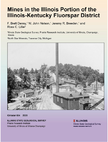| Mines in the Illinois Portion of the Illinois-Kentucky Fluorspar District
|

|
| Series
|
Circular 604
|
| Author
|
F. Brett Denny, W. John Nelson, Jeremy R. Breeden, and Ross C. Lillie
|
| Date
|
2020
|
| Buy
|
Web page
|
| Report
|
PDF file
|
| Map
|
PDF file
|
The Rose Creek Subdistrict lies along the Rose Creek Fault, which underlies and aligns parallel with Rose Creek (Figure 10). This area is complex, with several faults apparently coming together (Baxter et al. 1967)[1]. Denny and Seid (2014)[2] mapped the area slightly differently, but this particular area is very complex, and more data are needed to map the area properly. Burmeister (1952)[3] indicated that several boreholes were drilled through the main fault that intersects a mineralized fault striking N 50° E and dipping 80° SE. Burmeister (1952)[4] also stated that the Waltersburg Sandstone was present at the collar of the Knox Mine and that the fault was normal, with a displacement of 380 feet. Weller et al. (1952)[5] traced the Rose Creek Fault in both directions for a distance of several miles.
Mines in the Rose Creek Subdistrict2
| Rose Creek Mines—Conley and Smee Shafts
|
| The Rose Creek Mines were operated by the Yingling Mining Company from 1942 to 1948 (Davis 1943, 1950)[6][7]. These mines were also called the Yingling Mines (Burmeister 1952)[8]. In 1942, Harve Smee sunk the Smee Shaft to 100 feet and drove drifts at the 50- and 100-foot levels (Burmeister 1952)[9]. The Conley Shaft was originally sunk to 90 feet (Burmeister 1952)[10] but was later deepened to more than 300 feet. The vein lies along a fault trending N55°E and dipping 80°SE (Weller et al. 1952)[11]. Ozark-Mahoning mine maps indicated that the Conley Shaft was located in the middle of the mine workings. Working levels at 155, 215, 285, and 350 feet extended to the northeast and southwest along the fault away from the Conley Shaft. The Smee Shaft was at the northeast end of the mine and was also worked at the 50-foot level. The Minerva Oil Company commenced underground drilling in 1952, and the company reported low-grade ore below the 350-foot level between the main fault and the hanging wall fault. Most all of the exploration borings were drilled in a northwesterly or southeasterly direction to intersect a northeasterly striking fault or vein. Ozark-Mahoning maps suggest that a parallel fault, hosting 40% to 60% CaF2 ore, was present to the southeast and that between the two faults, lower grade mineralization attaining 15% to 20% CaF2 was present (Figure 10). Production at this mine from 1942 to 1949 was 8,500 tons of 60% CaF2 ore and 3,450 tons of 35% to 50% CaF2 ore (Burmeister 1952)[12]. In 1951, the Yingling Mining Company sold the Rose Creek property to the Minerva Oil Company (Holtzinger and Arundale 1955)[13]. Ozark-Mahoning mine maps indicate that additional ore was present along the master fault and in an east orebody. Minerva Oil Company reserve calculations from 1953 detailed that an additional 324,000 tons was possible along the master fault and that 97,000 tons was possible along the east orebody. Although the east orebody was 160 feet thick, with the top at 230 feet below the surface, the ore was low grade in sandstone and averaged about 19.6% CaF2. A hanging wall orebody was also present southeast of the Conley Mine workings. More information is needed to determine whether the low-grade ore was ever mined.
|
References

